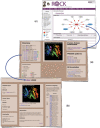MoKCa database--mutations of kinases in cancer
- PMID: 18986996
- PMCID: PMC2686448
- DOI: 10.1093/nar/gkn832
MoKCa database--mutations of kinases in cancer
Abstract
Members of the protein kinase family are amongst the most commonly mutated genes in human cancer, and both mutated and activated protein kinases have proved to be tractable targets for the development of new anticancer therapies The MoKCa database (Mutations of Kinases in Cancer, http://strubiol.icr.ac.uk/extra/mokca) has been developed to structurally and functionally annotate, and where possible predict, the phenotypic consequences of mutations in protein kinases implicated in cancer. Somatic mutation data from tumours and tumour cell lines have been mapped onto the crystal structures of the affected protein domains. Positions of the mutated amino-acids are highlighted on a sequence-based domain pictogram, as well as a 3D-image of the protein structure, and in a molecular graphics package, integrated for interactive viewing. The data associated with each mutation is presented in the Web interface, along with expert annotation of the detailed molecular functional implications of the mutation. Proteins are linked to functional annotation resources and are annotated with structural and functional features such as domains and phosphorylation sites. MoKCa aims to provide assessments available from multiple sources and algorithms for each potential cancer-associated mutation, and present these together in a consistent and coherent fashion to facilitate authoritative annotation by cancer biologists and structural biologists, directly involved in the generation and analysis of new mutational data.
Figures



References
-
- Daley GQ, Van Etten RA, Baltimore D. Induction of chronic myelogenous leukemia in mice by the P210bcr/abl gene of the Philadelphia chromosome. Science. 1990;247:824–830. - PubMed
-
- Burnworth B, Arendt S, Muffler S, Steinkraus V, Bröcker EB, Birek C, Hartschuh W, Jauch A, Boukamp P. The multi-step process of human skin carcinogenesis: a role for p53, cyclin D1, hTERT, p16, and TSP-1. Eur. J. Cell. Biol. 2007;86:763–780. - PubMed
-
- Hanahan D, Weinberg RA. The hallmarks of cancer. Cell. 2000;100:57–70. - PubMed
-
- Sawyers C. Targeted cancer therapy. Nature. 2004;432:294–297. - PubMed

